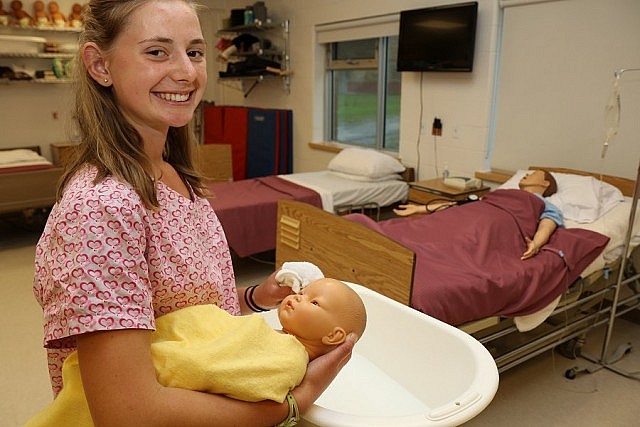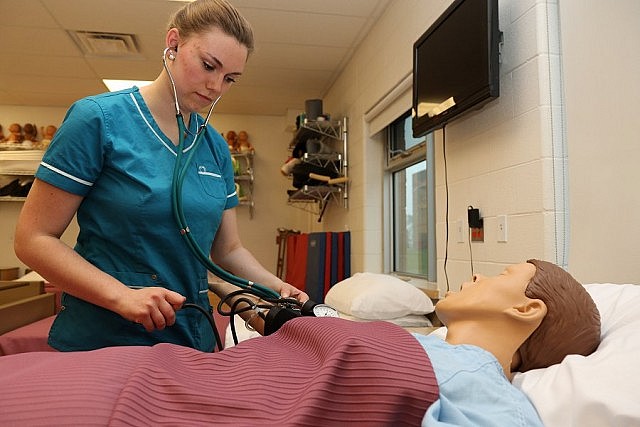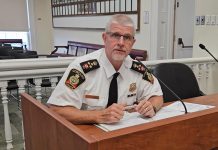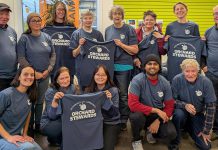
Cassie Peeters has wanted to be a doctor for as long as she can remember — she just wasn’t sure if she was cut out for it.
That’s why the chance to specialize her high school education in a health and wellness program appealed to her. Now she’s headed to university to learn about neurological and psychological studies before she takes that step into medicine.
“The program gave me the chance to try something I thought I would like to make sure I liked it, and also to get ahead,” Peeters says.
Peeters, 17, is one of a handful of students at St. Thomas Aquinas Catholic Secondary School in Lindsay who has the chance each year to test their aptitudes, hone their skills, and learn how well suited they are for the health and wellness sector.
The Specialist High Skills Major (SHSM) in Health and Wellness program gives about 30 students each year the chance to do just that. They still take classes with their peers, but also complete assignments that relate directly to the field. They’re able to complete sector-related certifications and complete a co-op placement.
“Being in the SHSM program really clarified my path for me,” Peeters says. “It made me realize, ‘Yes, I can do this.'”

And Grade 11 student Nick Goffredo, 17, thinks he might go the same route; his sister took the SHSM in Health and Wellness and he shared his sister’s passion to understand the human body and how it works. Goffredo has another year to go in the program, and says he is keeping his options open, considering business as well as health studies or paramedic education for his future.
“I am still not sure, but I’m still glad I took the SHSM,” he says. “It has really helped to give me a taste of what health care would be like.”
Since 2006, when the SHSMs were introduced at schools in the Peterborough Victoria Northumberland and Clarington Catholic District School Board (PVNC), the program has grown from 63 students to 519; province-wide, 44,000 high school students have chosen this route for their Grade 11 and 12 years. Locally, Board student success consultant Jane Sammut says SHSMs have “tremendous” success rates, having significantly boosted graduation rates in the board.
And yet she says that’s just one measure of the program’s success.
“The level of confidence of students in the program really goes up,” she says, adding that she predicts the SHSMs will continue to grow exponentially as students and parents learn of the lifelong benefits. Apart from confidence, Sammut cites the many certifications students can achieve, the community placement that opens doors to jobs, the possibility of post-secondary credit, and the workplace skills and habits fostered by the program.
In 2014/15, the Health and Wellness SHSM was the most popular SHSM province-wide, with 259 programs offered at high schools around the province. Within PVNC high schools, 14 different majors were offered, ranging from the second-most popular program province-wide, Arts and Culture, to Construction, Aviation, and the Health and Wellness Program.
And, administrators at PVNC commit more of their budget than the provincial average to training teachers and fostering community partnerships in their SHSM programs, something that directly impacts the students.
Marie Rayner was a registered nurse before she went back to school to become a teacher; now she teaches the Health and Wellness SHSM program at St. Thomas Aquinas, and she says the partnerships with community agencies are a big draw — and benefit — to students.
When a Grade 10 student chooses to focus their Grade 11 and 12 years in an SHSM, they also open the door to a number of career-preparing opportunities. In the Health and Wellness program, that means the chance to certify in First Aid, CPR, Ambulation, Infection Control, Medical Terminology, Hand-washing Protocol, and the list goes on.
“Those certifications stay on a student’s record, on their resume,” Rayner says. They’re also part of their skill set, forever.
The same is true for the other majors: certifications — and a better chance at a job — are perks that are hard to turn down, regardless of the stream a student is following: academic, university, college or apprenticeship/workplace. While the SHSM programs are sometimes thought to appeal particularly to students at-risk of failing graduation requirements or leaving school, the benefits to any students make the program appealing to all, Sammut says.
Even if the student chooses another path after graduation, they can use the skills and certifications to work their way through college or university, Sammut points out.

And yet, even students who were reluctant to do a co-op placement, hail the benefits. Peeters has a job this summer as a pharmacy assistant in the same place at which she did her co-op; both Kaczmarek and Goffredo got part-time jobs at Caressant Care in Lindsay, where they did their placements. In fact, Goffredo says the one thing some people are reluctant to do is actually a “really good reason to take the SHSM.” The level of confidence of students in the program really goes up.
“It really helps to clarify, ‘Is this what I want to do?'” he says.
The three of them clearly demonstrate the benefits of the program on the simulated mannequins in the lab classroom. They are able to take a patient’s vital signs, do proper patient transfers, and they have all the hand-washing skills they’ll ever need. All that, on top of the regular math and literacy skills and courses needed for graduation.
And a few stories to tell their peers.
“My friends are sometimes a little jealous when I tell them what we’ve been doing in the lab, or what we’re going to do,” Peeters says.
They might just also be asking that “What If” question: What if I’d taken a SHSM?
Take a tour of PVNC’s 21 Century Classrooms by visiting their Twitter feed @PVNCCDSB and Facebook page at www.facebook.com/PVNCCDSB.
Photos by Galen Eagle / PVNC Catholic District School Board


























